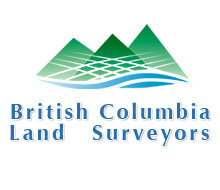Geomatics in Action: How to Survey for Olympic Running Tracks
Shared by the Association of BC Land Surveyors. Written by George Miller.
There are many running tracks with Olympic standard events in B.C. At one time, the running events had to be certified by a British Columbia Land Surveyor, hence my input starting in 1972.
The standards and rules are provided by: The International Amateur Athletic federation, 17 rue Princesse Florestine, BP 359-MC 98007, Monaco, Cedex (http://www.iaaf.org).
However, you can find all the facts at BC Athletics, whom I have always found helpful:
BC Athletics,3820 Cessna Drive, Ste 120, RICHMOND,BC V7B 0A2 … Phone: 604-333-3552, Fax: 604-333-3551 (www.bcathletics.org).
Before laying out any new or re-surfaced running track, you should always follow the latest IAAF plan and handbook. Attached are:
(a) The IAAF Plan 2008
(b) The IAAF Plan 1995 (note that events same, but symbols changed)
(c) Some old BC Tracks.
In marking tracks, we first start with lanes. Examining the 2008 track, the paint radius is 36.5m and the tangent is 84.39m. Each lane is 1.22m. The runner in lane 1 must maintain an offset of 0.3m from the curb line The runner’s offset in all other lanes is 0.2m. All white and other lines are 5cm wide. The 400m run is calculated from lane 1. offset of 0 . 3m.
3 6. 5 + 0. 3=3 6. 8x2x π+2×8 4. 3 9 = 400. 0 0 0m.
Setting out the marks on new construction is generally straight forward because most track contractors know what they are doing. The curb, which sets everything, is generally in the right place. On old tracks, that are about to be re-surfaced, it is helpful to check the old surface before it is destroyed and replaced. Otherwise, you have to fit in new control, which can be a challenge. If you have to “tweek”, slightly, your radii must be equal, your tangents should be equal and parallel and of course, you must have 400.000m on the 0.3 offset in Lane l. You should notify the track authorities of the slight changes, who should, in turn, notify BC Athletics. They may require a new plan from you.
If there are no pipes in the way, you may wish to set control at the centre points below the sod. Your BCs at points A,B,C,D should have concrete nails on the paint radii on Lane 1. and the far side of Lane 8. There should be at least four additional sets of paint marks for all lanes between the BC’s. All marks should be set on the runner’s side of the lane.
On the end curves, however, many marks are required. The distances between marks on the outside of lane 8 should not exceed lm, if set radially from the centre. (There are over 1300 paint marks on each curve). I find that a steel tape is useful for this tedious task.
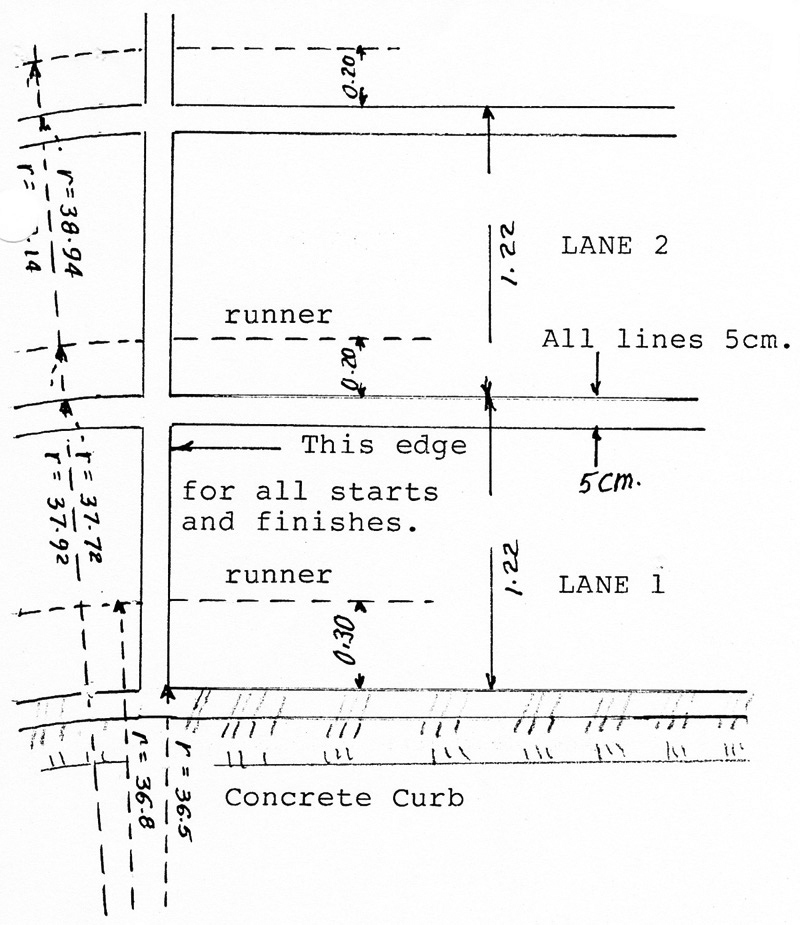
Intervals of 1.22m are set from 0.0 to 9.760. Adhesive electricians tape is then wrapped at each mark(same side) to hold the mark. The tape is then stretched from BC nails, marked at the centre and checked to the BC opposite. The track must be dry for paint marks. The person at 0.0 must be experienced. When the tape is tensioned, it rides on the curb. Lane 8 is marked and held. The tape is released slightly at centre so that the marker at lane 1 can push down and hold the tape on the track to allow the gang of markers to place paint dots on all the lanes. High school athletes make excellent markers. A total of six markers are required to get the job done quickly. It is generally easier to proceed counter clockwise because the marker in lane 1 can hold the tape in the left hand and mark with the right. There should be “moan and groan” stops about every 15 minutes for stretching and exchanging positions etc. It generally takes 1 1/2 to 2 hours for each end.
You should not mark any events until the lanes are painted. The normal procedure is to paint the 110m lanes and the other tangent lanes first. You can then mark all the events in these areas while he goes delirious painting circles.
All BCs, start lines, events, and curved lines between lanes should be “snapped” by a chalk line to assist the painter. The start lines in the straight are:
60m (not shown on IAAF Plan)
80m (not shown on IAAF Plan) Hurdles are White
100m Hurdles are Yellow
110m Hurdles are Blue

**(not shown on IAAF Plan)
I find it easier to mark these hurdles in reverse order from Finish Line.
On the main track, the 200m, 300m and 400m start and remain in lanes. It is convenient to tabulate this part of the track, as follows:
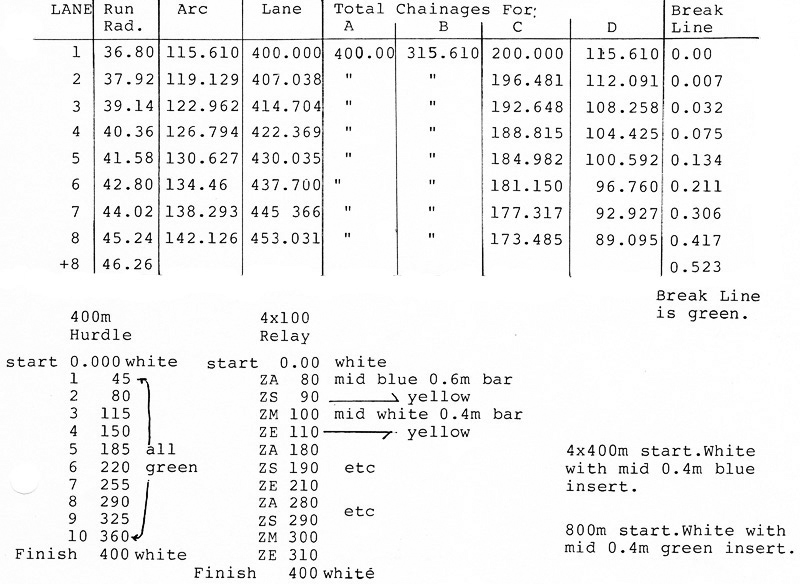
The 4x400m and the 800m are run partially in lanes. See examples 1 and 2.
See example 2 for curved start line A and C.
See example 3 for curved start line for 1 Mile race.
See example 4 for the compound 300m curved start.
The group start for the 10,000m race in lanes 5 to 8, where the runners run in lane 5 to the break line, starts exactly at the 800m start. For the 5000m group start in the same lanes diagonally across the track, there is no break line. The curved start begins exactly 0.134m ahead of the 200m start. The runners run in lane 5 and break out at a 5cmx5cm green square set exactly 0.134m past the BC line, between Lane 4 and 5.
Steeplechase Races:
The Steeplechase length is 396.084m.
The 1500 sc is an old race not shown on the IAAF Plan, but many users still like it. The 1st lap is run in the 400m lane before running through the water trap. The curved start begins 88.252m in lane 1 towards D.
2000m sc curved start in lane 1 is 19.58m from the finish line towards B.
3000m sc runs 1 lap in lane l. The curved start in lane 1 is 27.412m from C towards D.
Steeplechase hurdles start at the water jump for 5 equidistant hurdles around the track. 0.125×0.125 blue squares are placed inside lane 1 and outside lane 3.
Some running tracks require training marks set in lanes, where the runner stays in that lane until the distance ends at the Finish Line.
The training marks for 150m, 500, 600, 800, 1000m are set in all lanes. The training marks for the 3km, 5km, 8km 10km, 2Mi, 3Mi, 5Mi and 6Mi are generally set in lanes 5-8.
You will probably be asked to lay out the lines for the long jump, the high jump, pole vault, shot circle, discus circle, hammer circle, Javelin runway and landing (consult the latest IAAF Handbook).
I hope I haven’t forgotten too much.
I wish you every success. Be careful of some of the self- proclaimed experts-there are lots.
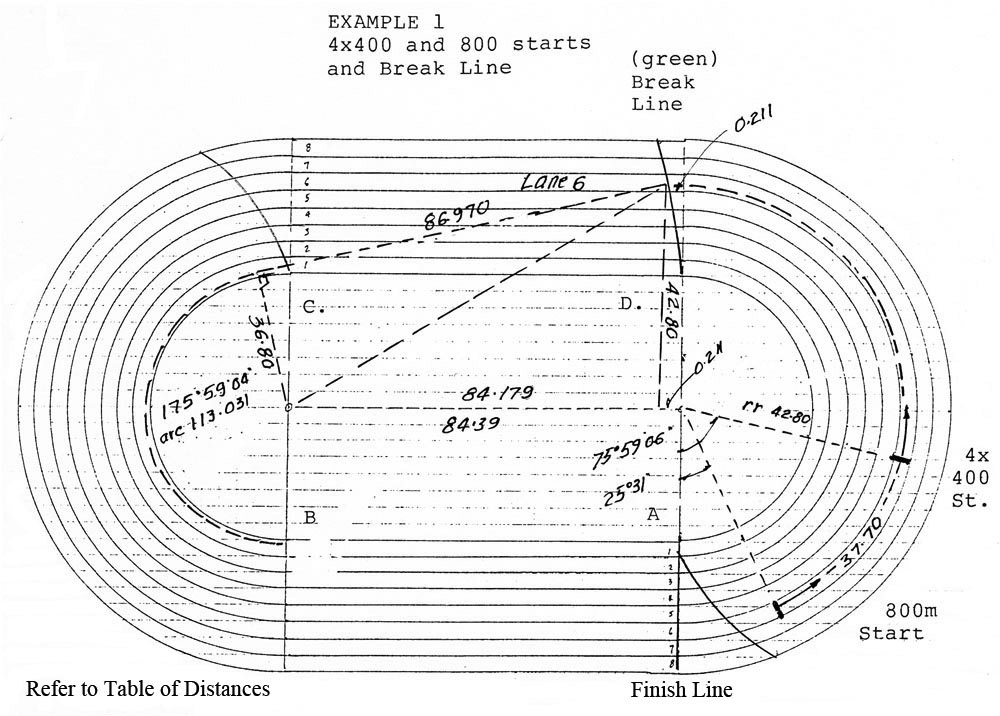 The 800m start must be exactly 400m from the Finish Line. Reversing from the Finish line, 400-284.39-0.211 = 115.399.90°in Lane 6 is 134.46m. Deducting 115.399 = 19.061m from F.L.(as per IAAF plan).
The 800m start must be exactly 400m from the Finish Line. Reversing from the Finish line, 400-284.39-0.211 = 115.399.90°in Lane 6 is 134.46m. Deducting 115.399 = 19.061m from F.L.(as per IAAF plan).
Since the runner in the 4×400 relay must run Lane 6 completely, the 2nd lap must be 800m at the F.L. 800-284.39-0.211- 437.70 = 77.69, which is the extra length in Lane 6 that the runner must run. The whole of Lane 6 is 437.70m.90°, as above is 134.46m. Deducting 77.69 = 56.761 (as per IAAF plan). The 1st exchange zone for the 4×400 relay is -10m and +10m from the 800m start.56.761-19.061 = 37.70. Deducting from 437.70m = 400m exactly for the 800m start. All other exchange zones are -10m and +10m from the F.L.
The distance in Lane 1 from B to D is exactly 200m. All break line distances must equal 200m, as well. The small ordinates between the break line and the B.C can be solved by iterations on a programmable calculator.
4x400m start. White with mid 0.4m blue insert.
800m start. White with mid 0.4m green insert.
For curved starts, place paint marks at runner’s offset.
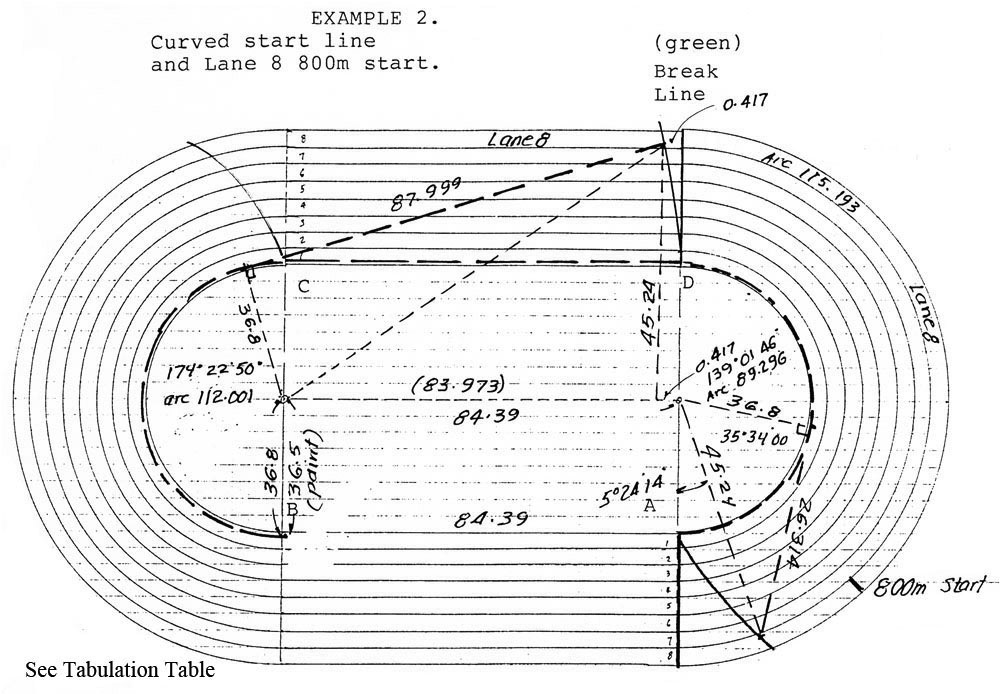 All distances from curved start to D are equal, 115.610m. All lanes except lane 1 are solved this way, including curved start at C.
All distances from curved start to D are equal, 115.610m. All lanes except lane 1 are solved this way, including curved start at C.
All distances from break line to B are equal, 200.000,m. The small distances between the BC and Break Line must be included. For curved starts, place paint marks at runner’s offset.
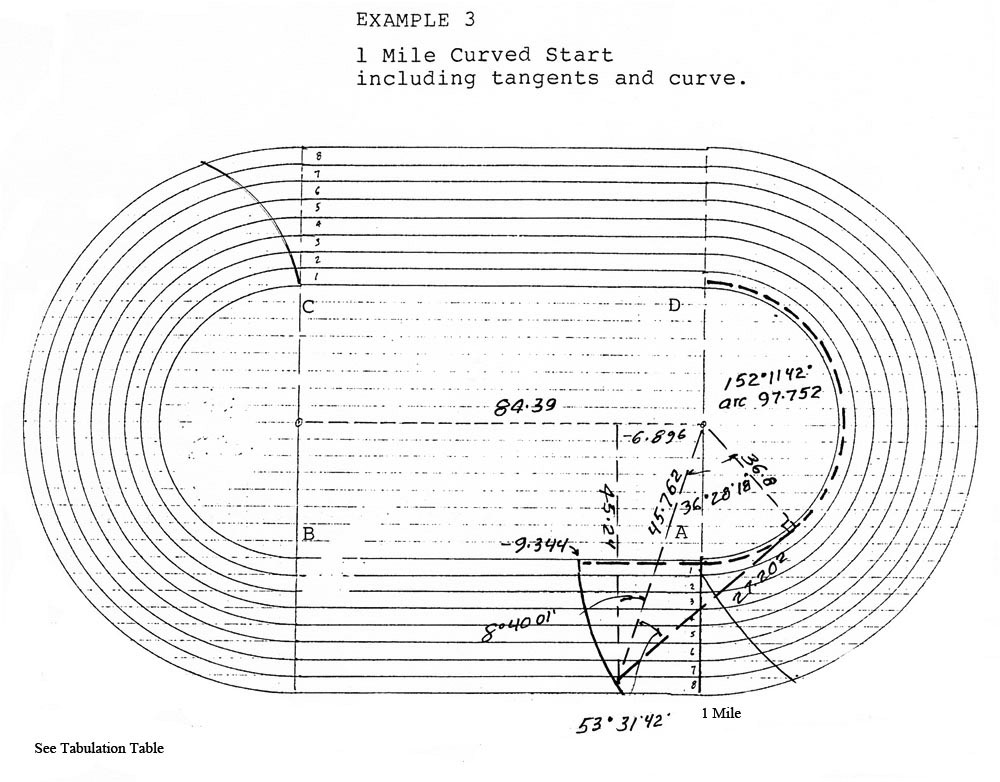
All distances from the curved line to D are equal, 124.954. I find iterations with a programmable calculator works well. For curved starts, paint marks must be placed at runner’s offset.
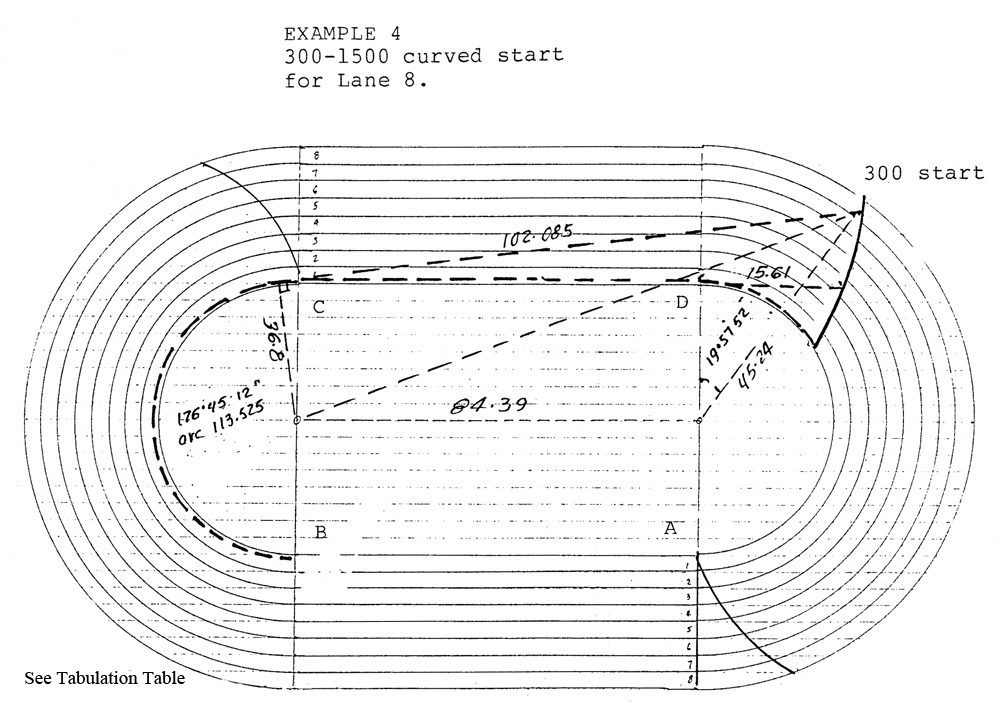
Lanes 1 to 3, where the distance is 15.61m can be solved as per Example 2.
Runners 4 to 8, however can see the curve at C, so all distances from the curved start to B must be equal, 215.61m. Again, iterations are my favourite method for solutions. For curved starts, paint marks must be placed at runner’s offset.




